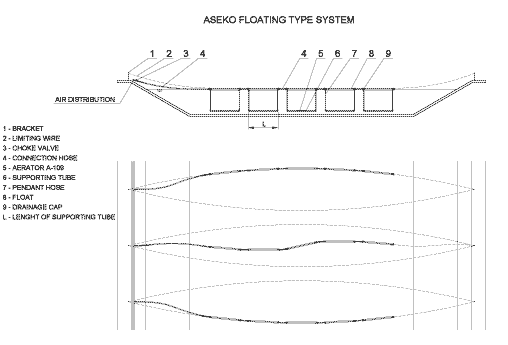Supporting tubes (6)
with aerators (5)
are balanced against upward hydrostatic pressure by inside load. Each
supporting tube is suspended on an independent float (8),
which is floating on water-level by means of two pendant hoses (7).
The float with suspended supporting tubes and aerators are arranged into
aerating lines. The floats are connected with each other and fixed to
the air distribution with the help of a flexible hose (4).
The aerating line is connected to the air distribution either from one
side or from both sides. Air distribution, for each aerating line is provided
with branches with spherical valves (3).
Air passes to the supporting tubes through this valve, the connecting
hose (4), the
inner space of floats (8)
and the pendant hoses (7).
The spherical valve serves to shut air off to individual aerating lines.

Each supporting tube is equipped with a mechanism to drain
condensed water from the air. A small tube is led from the drainage cap
(9), positioned
at the upper side of the float (8),
to the bottom part of the inner supporting tube). After opening of drainage
cap and with the system operating fully, internal air overpressure discharges
the condensed water from the supporting tube above the water level.
When the system is operating, water volume and the level around the float
rises due to the presence of air bubbles in water.
Due to natural irregularity of distribution of bubbles, a difference in
levels at the sides of the float occurs. This difference in levels forces
the float to move towards the lower water level.
This takes places with floats in the entire aerator line, where the supporting
tubes with aerators are made to float.
A limiting wire (2)
serves to limit the sideways movement of the aerating lines.
The wire is fastened to all floats in the line and its ends are fixed
to the opposite sides of the basin towards the (banks) braces (1).
After the aerator line reaches the edge, it swings behind the level of
the standing float due to the momentum of supporting tubes and as a result
the water level on the opposite side rises.
The floats in whole line start to move gradually back towards their second
extreme position. The movement of aerating lines from one extreme position
to the second is repeated all the time without mutual binding of individual
lines.

The floating type is mainly intended to aerate natural purification
and stabilisation basins of natural feature with irregular bottoms, ponds,
dam basins, fish-ponds etc.
It can also fully be used in activation, sludge and other waste water
treatment plants to ensure oxygen supply and adequate mixing.

The floating type can be used everywhere, where, due
to the irregular shape and to the size of basin, the aerating system cannot
be installed on the bottom. However it can be used in the classic and
structurally modified basins.
Installing of the floating type aerator is executed into filled basins.
Depth of immersion of the aerators is given by the length of pendant hoses.
Without stopping and pumping out basin, we can remove or re-install individual
supporting tubes for checking or repairing purposes . After it is removed
and reinstalled, it entirely preserves its original depth of immersion,
provided the same length of pendant hoses is maintained. Removing is done
manually from a boat
(2 operators).
Full-area aerating of tank and mixing of its contents is achieved due
to the movement aeration lines between adjustable extreme positions.
